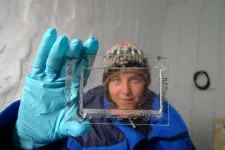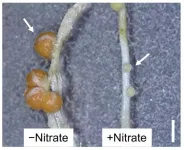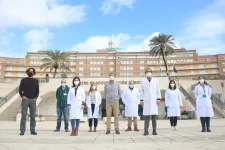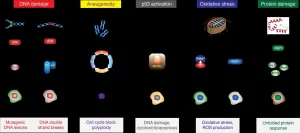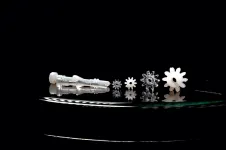(Press-News.org) A new biosealant therapy may help to stabilize injuries that cause cartilage to break down, paving the way for a future fix or - even better - begin working right away with new cells to enhance healing, according to a new animal-based study by researchers at the Perelman School of Medicine at the University of Pennsylvania. Their research was published in Advanced Healthcare Materials.
"Our research shows that using our hyaluronic acid hydrogel system at least temporarily stops cartilage degeneration that commonly occurs after injury and causes pain in joints," said the study's senior author, Robert Mauck, PhD, a professor of Orthopaedic Surgery and the director of Penn Medicine's McKay Orthopaedic Research Laboratory. "In addition to pausing cartilage breakdown, we think that applying this therapy can present a surface that is 'sticky' for cells, such as stem cells that are routinely injected into joints to counteract injury. This reinforcing hydrogel could actually synergize with those cells to create a long-term solution."
Articular cartilage is the tissue that covers the ends of bones at joints. It keeps bones from painfully grinding together, and its density and resilience allow it to undergo a lot of forces amid human movement. Unfortunately, these routine yet complex stresses cause cartilage to wear down easily - particularly amid some form of injury - and is hard to replace or regrow. This means that it is especially important to keep the remaining cartilage strong and stable.
To that end, Mauck, study lead author Jay Patel, PhD, a former post-doctoral fellow in the McKay Lab and now assistant professor at Emory University, and their team developed a therapy to use a modified version of hyaluronic acid - a substance naturally produced by the body's connective tissue - that could be introduced to the injured cartilage site. They recognized that this therapy needed to follow a twofold key to preserving cartilage: reinforcement and sealing.
"We often relate this combined approach to treating a damaged deck in your backyard," Patel said. "To fortify the existing wood structure, you need something like a wood hardener, then you can apply a wood sealer to prevent future wear. In the same way, we applied a substance that seeps into the pores of the tissue and provides reinforcement, then 'sealed' it by guiding the behavior of injected stem cells towards forming a layer that caps the whole structure."
In a large animal model, the researchers introduced the biogel to damaged cartilage, showing that it intertwined with the cartilage's matrix structure to stabilize the cartilage. They also demonstrated that it was retained for at least one week in the joint environment. When living cartilage was tested in the lab, the researchers found that applying the hyaluronic acid biogel restored regular activity to chondrocytes, the cells within cartilage tissue. This meant that the microenvironment around the cells was now being reinforced.
Once reinforced, the researchers shifted to sealing the cartilage, so that further tissue loss at the injury site didn't erode the cartilage's structure. To that end, the team combined the hyaluronic acid hydrogel system with an injection of mesenchymal stem/stromal cells, to promote the formation of a thin "living" barrier on the cartilage surface to protect it from further wear. When the researchers compared models that received the treatment to ones that did not, the treatment models displayed a thicker layer of protective tissue that could protect the cartilage's structure and preserve function.
"We've shown that this is an innovative technology and methodology for potentially addressing the complexities of treating damaged cartilage tissue that traditionally have made it so difficult," said Patel. "Next, we hope to translate this technology to more large animal studies and to the clinic in the near future."
These findings led to a translational grant from Penn Health Tech, the interdisciplinary center that combines teams from Penn Medicine and Penn Engineering to create new medical technology. Further, the technology is at the heart of a new company (Forsagen LLC) spun out of Penn with support from the Penn Center for Innovation (PCI) Ventures Program, which will attempt to spearhead the system's entry into the clinic. It is co-founded by both Mauck and Patel, along with study co-author Jason Burdick, a professor of Bioengineering at Penn, and Ana Peredo, a PhD student in Bioengineering.
INFORMATION:
Funding for this project was provided by Penn Health Tech, the Department of Veterans' Affairs, the National Science Foundation, and the National Institutes of Health (R01 AR056624, R01 AR077362, CMMI-1548571, IK1 RX003208, IK6 RX003416).
Other co-authors on this study include Claudia Loebel, Kamiel S. Saleh, Brian C. Wise, Edward D. Bonnevie, Liane M. Miller, and James L. Carey.
Editor's note: Mauck, Patel, and Burdick are equity holders, along with Penn, are equity holders in Forsagen LLC. They also stand to receive financial considerations from future commercialization of the technology.
Experts have uncovered a new molecular reason why faecal transplants are highly effective in treating infections such as C. difficile (a nasty bacteria that can infect the bowel), which could lead to more targeted treatments for this and other similar diseases.
The study, published today in Gastroenterology, was led by experts from the University of Nottingham and Nottingham Trent University.
Clostridium difficile, also known as C. difficile or C. diff, is a bacterium that can infect the bowel and cause diarrhoea. The infection most commonly affects people who have recently been treated with antibiotics. It can spread easily to others.
A stool transplant - or to give it its full title "a faecal ...
New York, NY (April 9, 2021) - Sets of genes associated with resistance to immunotherapy in patients with metastatic urothelial cancer of the bladder have been identified and validated by researchers at Mount Sinai. In a study published in Clinical Cancer Research, the team uncovered gene signatures representing adaptive immunity and pro-tumorigenic inflammation that were responsible for sensitivity or resistance to immune checkpoint inhibitors, drugs that help the body's immune system recognize and attack cancerous cells.
"These findings enabled us to identify potential biomarkers in patients who are less likely to respond favorably to immune checkpoint inhibitors, as well as new combination therapeutic approaches that might overcome such resistance ...
Nine out of ten Danes say that they will accept the COVID-19 vaccine when offered. This is the same level as before the AstraZeneca vaccine was paused.
This is shown by a questionnaire-based survey collected by Søren Dinesen Østergaard and co-authors. He is professor at the Department of Clinical Medicine at Aarhus University and affiliated with the Department of Affective Disorders at Aarhus University Hospital, Psychiatry.
"In February 2021, we asked a sample of Danes whether they were willing to be vaccinated against the coronavirus, and 89 per cent replied that they would. This picture was unchanged when the same people were asked again after the pausing of the AstraZeneca vaccine," says Søren Dinesen Østergaard. ...
Throughout the last ice age, the climate changed repeatedly and rapidly during so-called Dansgaard-Oeschger events, where Greenland temperatures rose between 5 and 16 degrees Celsius in decades. When certain parts of the climate system changed, other parts of the climate system followed like a series of dominos toppling in succession. This is the conclusion from an analysis of ice-core data by a group of researchers that included postdoc Emilie Capron and associate professor Sune Olander Rasmussen from the Section for the Physics of Ice, Climate and Earth at the Niels Bohr ...
Tsukuba, Japan - Plants in the bean family (legumes) form nodules on their roots to take up nitrogen. Legumes will stop nodule production when nitrogen is plentiful (Figure 1), but precisely how nitrate presence controls nodule formation in these plants has been a mystery. Now, researchers from Japan have found that interactions between proteins and nitrate can induce and repress genes, controlling nodulation with potential applications in sustainable agriculture.
In a study published in April in The Plant Cell, a research team from the University of Tsukuba has shown that the different DNA-binding properties between proteins that establish nodule development determine if genes involved in symbiosis that govern nodulation turn on or off and that ...
Two studies led by the Mental Health Unit of the Virgen del Rocio University Hospital and involving researchers from the US conclude that antipsychotic drugs could have a protective effect against SARS-CoV-2. For this reason, patients treated with these drugs have a lower risk of becoming infected or suffer a milder form of the disease if they do become infected.
Thus, a first descriptive epidemiological study of a sample of 698 patients treated with antipsychotics at the Seville hospital revealed that antipsychotic drugs could provide protection against both infection and the tendency to clinical severity of Covid-19 infection. "These are very interesting findings that reflect a clinical reality where we see few patients ...
Since the beginning of the coronavirus pandemic, scientists and physicians worldwide undertook enormous efforts to understand the disease caused by the virus. In their latest collaborative study, researchers from the Max Planck Institute of Immunobiology and Epigenetics in Freiburg and physicians from the University of Freiburg Medical Center unveil a novel feature of COVID-19 immunity, which could have implications for future therapies. The study points to the involvement of Interleukin 33, an important danger signal, when immune cells encounter Sars-CoV-2 for a ...
An international group of scientists led by the RIKEN Cluster for Pioneering Research have studied the chemical composition of 50 protoplanetary-disk forming regions in the Perseus Molecular Cloud, and found that despite being in the same cloud, the amounts of complex organic molecules they contain are quite different. Interestingly, the chemically rich young disks have similar compositions of organic molecules. These findings raise an important question: do solar-like systems share a common chemistry at birth?
It was once believed that complex organic molecules were rare in the universe, and that this rarity ...
Imperial Brands scientists have utilised Toxys' ToxTracker suite of stem-cell based in-vitro assays, which provide mechanistic insight into the potential DNA damaging properties of chemicals, comparing vape e-liquid samples and their aerosols to combustible cigarette smoke.
Imperial scientists are the first to publish results using the ToxTracker system for the assessment of vape e-liquids and aerosols, and it forms part of the company's continuing research into the tobacco harm reduction potential of Next Generation Products (NGPs) such as vapes.
The assays help assess how product samples may impact cellular functioning across six reporter cell lines, picking up the tell-tale molecular signs of potential harm in the ...
Glass is ubiquitous, from high-tech products in the fields of optics, telecommunications, chemistry and medicine to everyday objects such as bottles and windows. However, shaping glass is mainly based on processes such as melting, grinding or etching. These processes are decades old, technologically demanding, energy-intensive and severely limited in terms of the shapes that can be realized. For the first time, a team led by Prof. Dr. Bastian E. Rapp from the Laboratory of Process Technology at the Department of Microsystems Engineering at the University of Freiburg, in collaboration with the Freiburg-based start-up Glassomer, has developed a process that makes it possible to form glass easily, quickly and in almost any shape using injection ...
